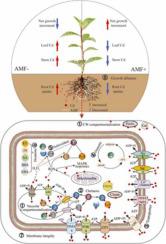Journal of Hazardous Materials ( IF 13.6 ) Pub Date : 2021-10-12 , DOI: 10.1016/j.jhazmat.2021.127430 Di Liu 1 , Kuanyu Zheng 2 , Yue Wang 1 , Yan Zhang 1 , Ruimin Lao 1 , Zhiyang Qin 1 , Tao Li 1 , Zhiwei Zhao 1

|
Populus yunnanensis Dode, a facultative metallophytic poplar, exhibits afforestation potential in barren mine tailing areas. However, the interactions and functional roles of arbuscular mycorrhizal fungus (AMF) in P. yunnanensis adaptability to heavy metal stress remain unclear. Physiological and molecular responses of P. yunnanensis plantlets to AMF (Funneliformis mosseae) under cadmium (Cd) stress (50 mg kg−1) were investigated. Results showed attenuation of Cd phytotoxicity effects on cell organelles upon AMF inoculation, which also reduced the Cd concentration in the poplar leaves, stems, and roots. Under Cd stress, AMF-blocking of metal transporter (e.g., Ca2+ channel) activity occurred, decreasing root cell Cd influx by reducing H+ efflux. Bioaugmentation of rhizosphere sediments by AMF to stabilize metals with a decreasing DTPA-extractable Cd also occurred. The AMF inoculation promoted Cd conversion into inactive, less phytotoxic forms, and helped to maintain ion homeostasis and relieve nutritional ion (e.g., Ca, Mg) disorders caused by excessive Cd. Leaf enzyme and non-enzyme antioxidant systems were triggered. Root and leaf physiological response patterns differed. The AMF regulated the poplar functional genes, and nine metal-responsive gene clusters were identified. We suggest that AMF is a functional component of P. yunnanensis phenotype extension, contributing to strong adaptability to unfavorable mine tailings conditions.
中文翻译:

利用丛枝菌根提高兼性金生杨(Populus yunnanensis)对镉胁迫的适应性:生理和分子反应
滇滇杨是兼性成矿性杨树,在贫瘠的尾矿区具有造林潜力。然而,丛枝菌根真菌(AMF)在云南松对重金属胁迫适应性中的相互作用和功能作用仍不清楚。研究了在镉(Cd)胁迫(50 mg kg -1 )下云南杨苗对AMF(Funneliformis mosseae )的生理和分子反应。结果表明,接种 AMF 后 Cd 对细胞器的植物毒性作用减弱,这也降低了杨树叶片、茎和根中的 Cd 浓度。在 Cd 胁迫下,金属转运蛋白(如 Ca 2+ )的 AMF 阻断通道)活动发生,通过减少 H +流出减少根细胞 Cd 流入。还发生了 AMF 对根际沉积物的生物强化,以稳定金属,同时 DTPA 可萃取 Cd 降低。AMF 接种促进 Cd 转化为无活性、植物毒性较小的形式,并有助于维持离子稳态并缓解由过量 Cd 引起的营养离子(例如,Ca、Mg)紊乱。叶酶和非酶抗氧化系统被触发。根和叶的生理反应模式不同。AMF调节杨树功能基因,鉴定出9个金属反应基因簇。我们认为 AMF 是P. yunnanensis表型扩展的功能成分,有助于对不利的尾矿条件具有很强的适应性。



























 京公网安备 11010802027423号
京公网安备 11010802027423号